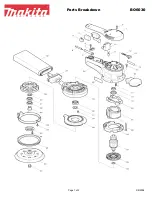
7
5.
Setup and assembly
The sander main unit requires no assembly. Set‐up
involves only removing sander from pallet, and
installing desired table insert and spindle/sleeve
combination.
5.1
Transport and installation
The machine is designed to operate in closed rooms
and must be placed stable on a firm and levelled
surface.
5.2
Additional tools required
Ratchet wrench with socket set (or adjustable wrench)
Cross‐point (Phillips) screwdriver
Machinist square
Straight edge
5.3
Unpacking and cleanup
Inspect all contents from shipping carton, including
parts inside cabinet (accessed through the side door).
Report any damage or part shortages to your
distributor.
Exposed metal surfaces, such as table surface, have
been given a protective coating at the factory. This
coating should be removed with a soft cloth moistened
with solvent, such as mineral spirits. Do not use
solvents with low flash points, or allow solvents near
plastic or rubber parts. Do not use an abrasive pad as it
may scratch exposed surfaces.
Periodically apply a light coat of paste wax or other
protectant to the table top to prevent rusting.
5.4
Removal from pallet
To remove sander from pallet:
1.
Open cabinet door and remove accessories.
2.
Use ratchet wrench with extended socket to
unscrew two bolts securing machine to pallet
(Figure 2).
3.
Move sander off pallet, with help from an
assistant.
Figure 2
5.5
Drum and spindle storage
Keep drums, spindles and table inserts protected by
storing them in cabinet (Figure 3). To open door, lift
bottom of latch and rotate counterclockwise 90
degrees (Figure 4). Reverse procedure to close cabinet
door.
Figure 3: cabinet storage








































